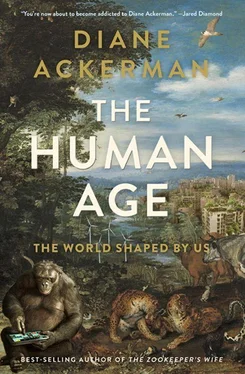Or picture the high-rise office and shopping complex Eastgate Centre in Harare, Zimbabwe, which was inspired by a throng of gigantic termite towers. Topped by turrets and pinnacles, a city of vaulted termite mounds can rise thirty feet from the parched earth like otherworldly castles, while millions of laborers and soldiers toil inside, presided over by king and queen, with offspring raised communally. It’s an agricultural society, whose favorite crop is a fungus that will only grow at 87°F. Yet outside the thick mud walls, temperatures can plunge to near freezing at night and soar to broiling by day. Winds snort and snap one moment and tap like weary ghosts the next. Our windmills and wind turbines require a steady flow of wind, and they’re stymied by turbulence. Termite engineers harness chaotic winds far more skillfully by using their mounds as inside-out lungs.
Deep inside each mountainous city, termites capture and trim even the most sputtering, heat-whipped, muddled winds to the precise vibration needed to ventilate the colony and keep their crops flourishing. As they open and close a filigree of low doors, the mound inhales a rush of air into a maze of chambers and passageways, and shoots it up to the buttresses and tiptop chimneys. They keep tweaking their design by opening and closing doors, digging new doors, sealing old ones, adding wet mud in spots for quicker cooling. Each termite is like one neuron in a collective brain. It doesn’t need to be smart, and none can see the whole picture, but together they create coherent action and a kind of intelligence. Constant gardeners, they fine-tune the breeze and provide a steady temperature, which keeps the tiny, blind population cozy.
We have this in common: they are great openers of doors, as we are, though their doors are physical and many of ours are symbolic. Some of their blade-shaped “compass” mounds are oriented toward the sun at a time-tested angle to avoid the roasting noonday sun, yet usher in evening’s faint rays. My house was designed on the same principle by its first owner—vaulted south-facing windows in the living room let in more winter sun and provide summer shade.
Singing can draw oxygen through even injured lungs, and the mud colony fills with a vibrato, reassuring its lodgers that all is well. On some level unknown to us, an out-of-tune mound must not sound right to the termites, who are driven to build the most exquisite lungs possible because their lives depend on it. Does this mean they have an aesthetics that’s shared by the whole colony? Who’s to say. It could be that, to them, out-of-tune air stings like a million arrows.
Inspired by mud casts of the mound’s baroque nooks and crannies, the African architect Mick Pearce designed the Eastgate Centre. Fans on the first floor spirit air through ducts into the central spine of the building, and stale air seeps through exhaust vents on each floor, exiting at last from high chimneys. A river of fresh air automatically replaces it. Using only 10 percent as much energy as nearby buildings, the eco-friendly Centre has saved the owners $3.5 million in climate control, which they’ve passed on to their tenants by lowering the rent. Ten years later, Pearce built the even more efficient ten-story Council House 2 building in Melbourne, Australia. This time, recycled wooden shutters, covering one whole side of the building, open like petals at night to expel the warm air from offices and shops. This works well in Africa, but in colder climes excess warmth can’t be wasted. And so, in some countries, furnaces now have two legs.
How intimate, how romantic, how sustainable of the French. As I waited with a throng of Parisians in Paris’s Rambuteau subway station on a blustery November day, my frozen toes finally began to thaw. Alone we may have shivered, but together we brewed so much body heat that people began unbuttoning their dark coats. We might have been emperor penguins crowding for warmth in Antarctica’s icy torment of winds.
Idly mingling, a human body radiates about 100 watts of excess heat, which can add up fast in confined spaces. Rushing commuters contribute even more, and heat also looms from the friction of trains on the tracks and seeps from the deep maze of tunnels, raising the platform temperature to around 70°F, almost a geothermal spa. As new people clambered on and off trains, and trickled up and down the staircases to Rue Beaubourg, their haste kept the communal den toasty.
Geothermal warmth may abound in volcanic Iceland, but it’s not easy to come by in downtown Paris. So why waste it? Instead mine people as a renewable green energy source. Tap even a fraction of the population, say, the heat cloud of subway commuters, and it’s a deep pocketful of free energy. In that spirit, savvy architects from Paris Habitat decided to borrow the surplus energy from all the hurrying bodies in the metro station and convert it into radiant underfloor heating for apartments in a nearby social housing project, which happens to share an unused stairwell with the station. Otherwise the heat borne through countless rushed breakfasts of croissant and café au lait, mind-theaters, idle reveries, and flights of boredom would be lost by the end of the morning rush hour. Opportunity warms.
Appealing as the design may be, it isn’t feasible throughout Paris without a pricey retrofit of buildings and metro stops. But it’s proving successful elsewhere. In America, there’s Minnesota’s prairielike monument to capitalism, the four-million-square-foot Mall of America. Even on subzero winter days the indoor temperature skirts 70°F from combined body heat, light fixtures, and sunlight cascading in through 1.2 miles of skylights. That’s just as well, since people can get married in the mall’s Chapel of Love on the third floor, next to Bloomingdale’s, and taffeta and chiffon aren’t the best insulators.
Or consider Scandinavia’s busiest travel hub, Stockholm’s Central Station, during morning rush hour on a blustery day in January. Outside, it’s -7°F, the streets are icy as a toboggan run, cold squirrels around your face, the air feels scratchy, and even in wool mittens your hands are tusks of ice. But indoors is another country, a temperate one filled with a living mass of humans heading in all directions. Pocketing the windfall, engineers are harnessing the body heat issuing from 250,000 railway travelers to help warm the thirteen-story Kungsbrohuset office building about a hundred yards away. Under the voluminous roof of the station, travelers donate their 100 watts of surplus natural heat, while visitors bustle around the dozens of shops, buying meals, drinks, books, flowers, cosmetics, and such, bestowing even more energy.
You can almost feel a gentle tugging at your skin. There’s a warm draft.
“Why shouldn’t we use it?” asks Klas Johansson, who works for Jernhusen, the state-owned developer of the project. “If we don’t use it it’s just going to be ventilated away.”
Citizen lamplighters, citizen furnace-stokers—antique corps of volunteers fill my imagination. All cheap and renewable. This ultragreen design works dramatically well in Sweden, a land of soaring fuel costs, ecologically minded citizens, and a legendary arctic winter becalmed by few hours of daylight and a horizon-hugging sun. Night blankets the city in stellar darkness by midafternoon. Offset as the night may be with cozy lantern-lit streets, candle-lit windows, and the luminous green ribbons and dancing halos of the northern lights, when cold clambers up the bones, more heat is the sole comfort. But fuel can take many forms, from fossil to solar energy, oil and gas to the residue left in paper mills, or Central Station’s… well, what shall we call it? As a technology it needs a catchy name, something sociable. Maybe “Auraglow,” “Beradiant,” “EnsnAired,” or “FriendEnergy”?
Читать дальше












